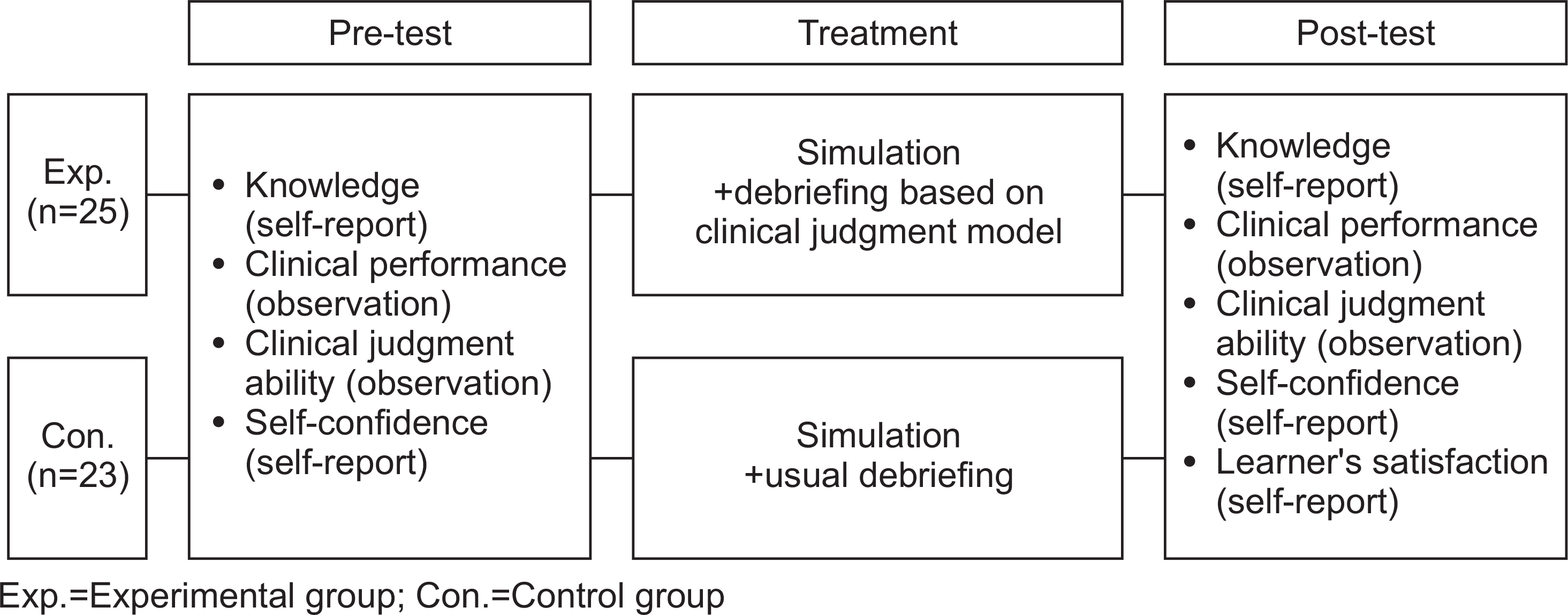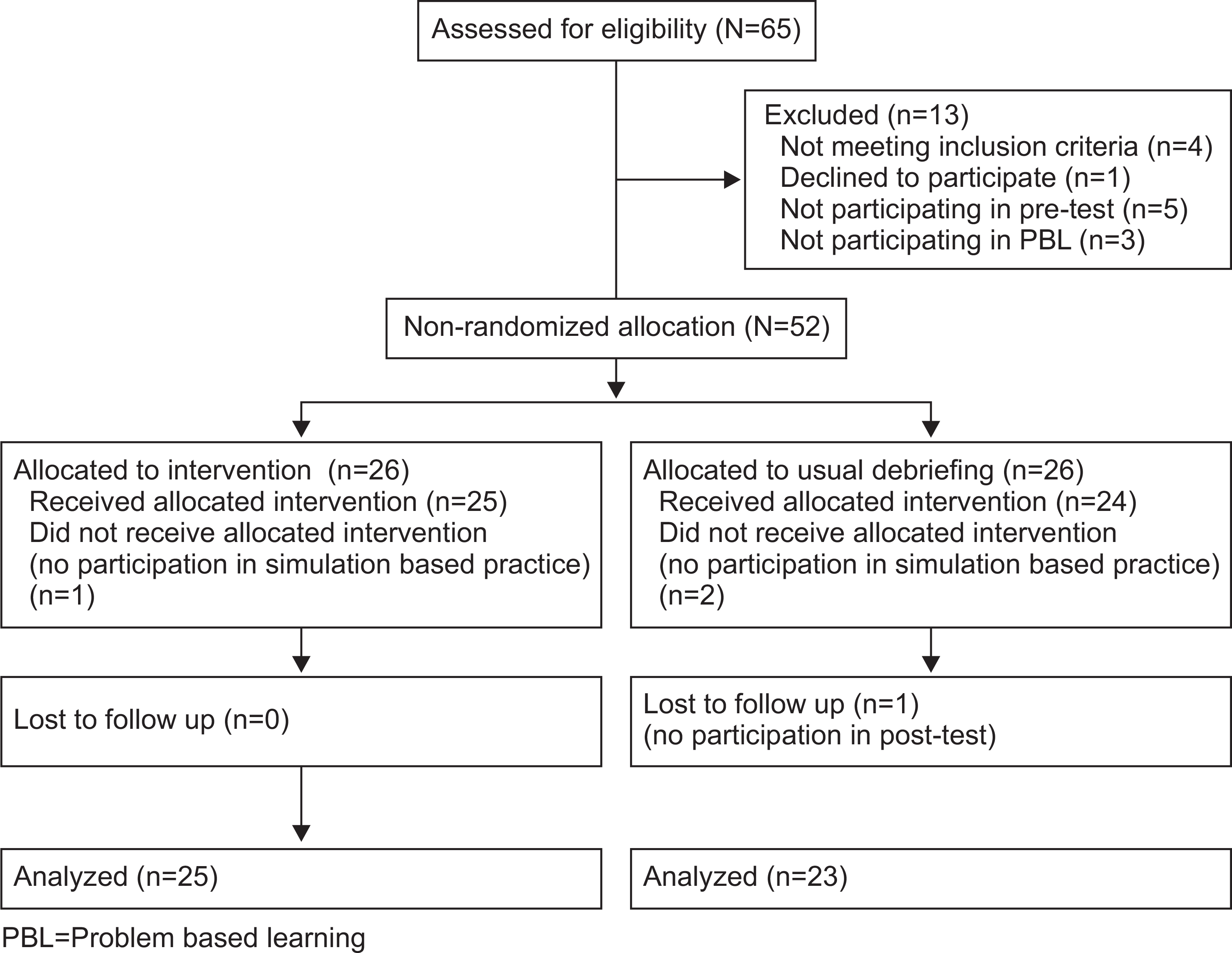Abstract
Purpose
This study was conducted to identify effects of debriefing based on the clinical judgment model for nursing students on their knowledge, skill performance, clinical judgment, self-confidence and learner satisfaction during simulation based end-of-life care (ELC) education.
Methods
Simulation based ELC education was developed in six steps as follows: selection of learning subjects and objects, development of learning tools, a trial run of simulation-based education, students’ skill training, and evaluators’ training. Forty-eight senior nursing students (25 in the experimental group and 23 in the control group) participated in the simulation-based ELC education using a high-fidelity simulator. Debriefing based on the clinical judgment was compared with the usual debriefing.
References
1. Korea National Statistical Office. Annual report on the cause of death statistics [Internet]. Daejeon: Korea National Statistical Office;c2015. [cited 2017 May 1]. Available from:. http://kostat.go.kr/portal/korea/index.action.
2. Caton AP, Klemm P. Introduction of novice oncology nurses to end-of-life care. Clinical Journal of Oncology Nursing. 2006; 10(5):604–608. https://doi.org/10.1188/06.CJON.604-608.

3. Hamilton CA. The simulation imperative of end-of-life education. Clinical Simulation in Nursing. 2010; 6(4):131–138. https://doi.org/10.1016/j.ecns.2009.08.002.

4. Sorensen R, Iedema R. Emotional labour: Clinicians’ attitudes to death and dying. Journal of Health Organization and Management. 2009; 23(1):5–22. https://doi.org/10.1108/14777260910942524.

5. Eun Y, Bang SY. Effects of the Lasater’s clinical rubric of debriefing in advanced cardiovascular life support training. Journal of the Korea Contents Association. 2016; 16(4):516–527. https://doi.org/10.5392/JKCA.2016.16.04.516.

6. Raemer D, Anderson M, Cheng A. Fanning R, Nadkarni V, Savoldelli G. Research regarding debriefing as part of the learning process. Simulation in Healthcare. 2011; 6(Suppl):S52–S57. https://doi.org/10.1097/SIH.0b013e31822724d0.

7. Kim EJ. Nursing students’clinical judgment skills in simulation: Using Tanner’s clinical judgment model. The Journal of Korean Academic Society of Nursing Education. 2014; 20(2):212–222. https://doi.org/10.5977/jkasne.2014.20.2.212.
8. Kim HJ. The effects of suction care self video-based debriefing-assisted learning in the fundamentals of nursing practice. Journal of Korean Academic Society of Home Health Care Nursing. 2015; 22(1):88–97.
9. Koh JH, Hur HK. Effects of simulation-based training for basic life support utilizing video-assisted debriefing on non-technical and technical skills of nursing students. Korean Journal of Adult Nursing. 2016; 28(2):169–179. https://doi.org/10.7475/kjan.2016.28.2.169.

10. Oh HK. Effects of debriefing applying the clinical judgment rubric on nursing students’ knowledge, skill performance and simulation effectiveness. Advanced Science and Technology Letters. 2015; 116:104–109. https://doi.org/10.14257/astl.2015.116.22.

11. Levett-Jones T, Lapkin S. A systematic review of the effectiveness of simulation debriefing in health professional education. Nurse Education Today. 2014; 34(6):e58–e63. https://doi.org/10.1016/j.nedt.2013.09.020.

12. Al Sabei SD, Lasater K. Simulation debriefing for clinical judgment development: A concept analysis. Nurse Education Today. 2016; 45:42–47. https://doi.org/10.1016/j.nedt.2016.06.008.

13. Tanner CA. Thinking like a nurse: A research-based model of clinical judgment in nursing. Journal of Nursing Education. 2006; 45(6):204–211.
14. Lasater K. Clinical judgment development: Using simulation to create an assessment rubric. Journal of Nursing Education. 2007; 46(11):496–503.
15. Nahm FS. Understanding effect sizes. Hanyang Medical Reviews. 2015; 35:40–43. https://doi.org/10.7599/hmr.2015.35.1.40.

16. Ministry of Health and Welfare. Introduction to hospice palliative care for palliative medical team members [Internet]. Goyang: National Cancer Center;c2012. [cited 2017 May 1]. Available from:. http://hospice.cancer.go.kr/index.do.
17. METI. Program for Nursing Curriculum Integration (PNCI) 2. Seoul: Yaksan Publishing Co.;2007. p. 1–50.
18. Shin H, Park CG, Shim K. The Korean version of the Lasater clinical judgment rubric: A validation study. Nurse Education Today. 2015; 35(1):68–72. https://doi.org/10.1016/j.nedt.2014.06.009.

19. Moreland SS, Lemieux ML, Myers A. End-of-life care and the use of simulation in a baccalaureate nursing program. International Journal of Nursing Education Scholarship. 2012; 9(1):https://doi.org/10.1515/1548-923X.2405.

20. Kim CS. Development and effect of high fidelity patient simulation education program for nursing students [dissertation]. Seoul: Catholic University of Korea;2012. p. 1–55.
21. Jeong KI. Attitudes toward death and terminal care in nursing students. Journal of the Daedong University. 2013; 20:235–249.
22. Jeffries PR. A framework for designing, implementing, and evaluating simulations used as teaching strategies in nursing. Nursing Education Perspectives. 2005; 26(2):96–103.
23. Ryoo EN, Ha EH. The importance of debriefing in simulation-based learning: Comparison between debriefing and no debriefing. Computers, Informatics, Nursing. 2015; 33(12):538–545. https://doi.org/10.1097/CIN.0000000000000194.
24. Chronister C, Brown D. Comparison of simulation debriefing methods. Clinical Simulation in Nursing. 2012; 8(7):e281–e288. https://doi.org/10.1016/j.ecns.2010.12.005.

25. Kelly MA, Hager P, Gallagher R. What matters most? Students’ rankings of simulation components that contribute to clinical judgment. Journal of Nursing Education. 2014; 53(2):97–101. https://doi.org/10.3928/01484834-20140122-08.

26. Lavoie P, Pepin J, Boyer L. Reflective debriefing to promote novice nurses’ clinical judgment after high-fidelity clinical simulation: A pilot test. Dynamics. 2013; 24(4):36–41.
27. Ha YK, Koh CK. The effects of mechanical ventilation simulation on the clinical judgment and self-confidence of nursing students. Perspectives in Nursing Science. 2012; 9(2):119–126.
28. Mariani B, Cantrell MA, Meakim C, Prieto P, Dreifuerst KT. Structured debriefing and students’ clinical judgment abilities in simulation. Clinical Simulation in Nursing. 2013; 9(5):e147–e155. https://doi.org/10.1016/j.ecns.2011.11.009.

29. Ha EH, Song HS. The effects of structured self-debriefing using on the clinical competency, self-efficacy and educational satisfaction in nursing students after simulation. The Journal of Korean Academic Society of Nursing Education. 2015; 21(4):445–454. https://doi.org/10.5977/jkasne.2015.21.4.445.

30. Ministry of Foreign Affairs. OECD 「PISA in Focus」 [Internet]. Seoul: Ministry of Foreign Affairs;c2015. [cited 2017 Sep 1]. Available from:. http://mcms.mofa.go.kr/webmodule/htsboard/template/read/hbdlegationread.jsp?typeID=15&boardid=11076&seqno=1170376&c=TITLE&t=&pagenum=1&tableName=TYPE_LEGATION&pc=&dc=&wc=&lu=&vu=&iu=&du=.
Table 1.
Homogeneity Test of Characteristics of Subjects (N=48)
Table 2.
Homogeneity Test of Dependent Variables (N=48)
Table 3.
Comparison of Learning Outcomes between Two Groups at Posttest (N=48)




 PDF
PDF ePub
ePub Citation
Citation Print
Print




 XML Download
XML Download